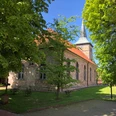- Photos & Map
How would you like to arrive?
- Call
- Description
- Good to know
- Nearby
In 1148, Count von Hallermund founded a Benedictine monastery on his estates to the left of the Weser in the county of Hoya. The Bishop of Minden confirmed the monastery in 1155 and entrusted it to the protection of St. Vitus. In 1528, under massive pressure from the Counts of Hoya, the monastery had to relinquish control of its property and from then on no longer accepted novices.
In 1560, Count Erich von Hoya had the old monastery church demolished in order to use the stones to enlarge his castle in Stolzenau. He then had a half-timbered church built as atonement, in which the congregation celebrated services for over 300 years. It is still preserved alongside large parts of the former monastery buildings and, like them, is a listed building. The outer walls of the south and west wings are still preserved. The former windows of the cloister with a view of the inner courtyard are walled up, but still exist in their old form. The old abbey also still exists. The half-timbered church, built in 1539/1540, was initially built as an emergency church and later used as a stable. As a result, the valuable wall paintings inside have been preserved. The carved altar from the first monastery church can now be found in St. Vitus Church in Schinna.
After the death of the last abbot, the monastery's land was managed by various tenants. In 1876, a separate state domain was formed from the former monastery estate, leased out and a new tenant's house was built. Overall, it is a monument of supra-regional significance and an important center of village life in the district of Schinna. The Benedictine monastery was first mentioned 860 years ago and many details have survived the centuries. Appointments for guided tours can be arranged individually.
Couples can have a civil wedding here in a festive atmosphere beneath historic murals. The church offers seating for up to 60 people. A champagne reception on the monastery grounds and bringing along music are also possible (information: registry office of the Mittelweser municipality, tel. 05761-705212).
In 1560, Count Erich von Hoya had the old monastery church demolished in order to use the stones to enlarge his castle in Stolzenau. He then had a half-timbered church built as atonement, in which the congregation celebrated services for over 300 years. It is still preserved alongside large parts of the former monastery buildings and, like them, is a listed building. The outer walls of the south and west wings are still preserved. The former windows of the cloister with a view of the inner courtyard are walled up, but still exist in their old form. The old abbey also still exists. The half-timbered church, built in 1539/1540, was initially built as an emergency church and later used as a stable. As a result, the valuable wall paintings inside have been preserved. The carved altar from the first monastery church can now be found in St. Vitus Church in Schinna.
After the death of the last abbot, the monastery's land was managed by various tenants. In 1876, a separate state domain was formed from the former monastery estate, leased out and a new tenant's house was built. Overall, it is a monument of supra-regional significance and an important center of village life in the district of Schinna. The Benedictine monastery was first mentioned 860 years ago and many details have survived the centuries. Appointments for guided tours can be arranged individually.
Couples can have a civil wedding here in a festive atmosphere beneath historic murals. The church offers seating for up to 60 people. A champagne reception on the monastery grounds and bringing along music are also possible (information: registry office of the Mittelweser municipality, tel. 05761-705212).
Good to know
Openings
The site can be visited at any time.
Author
Mittelweser-Touristik GmbH
Lange Straße 18
31582 Nienburg/Weser
Organization
Mittelweser-Touristik GmbH
License (master data)
Mittelweser-Touristik GmbH
Nearby









